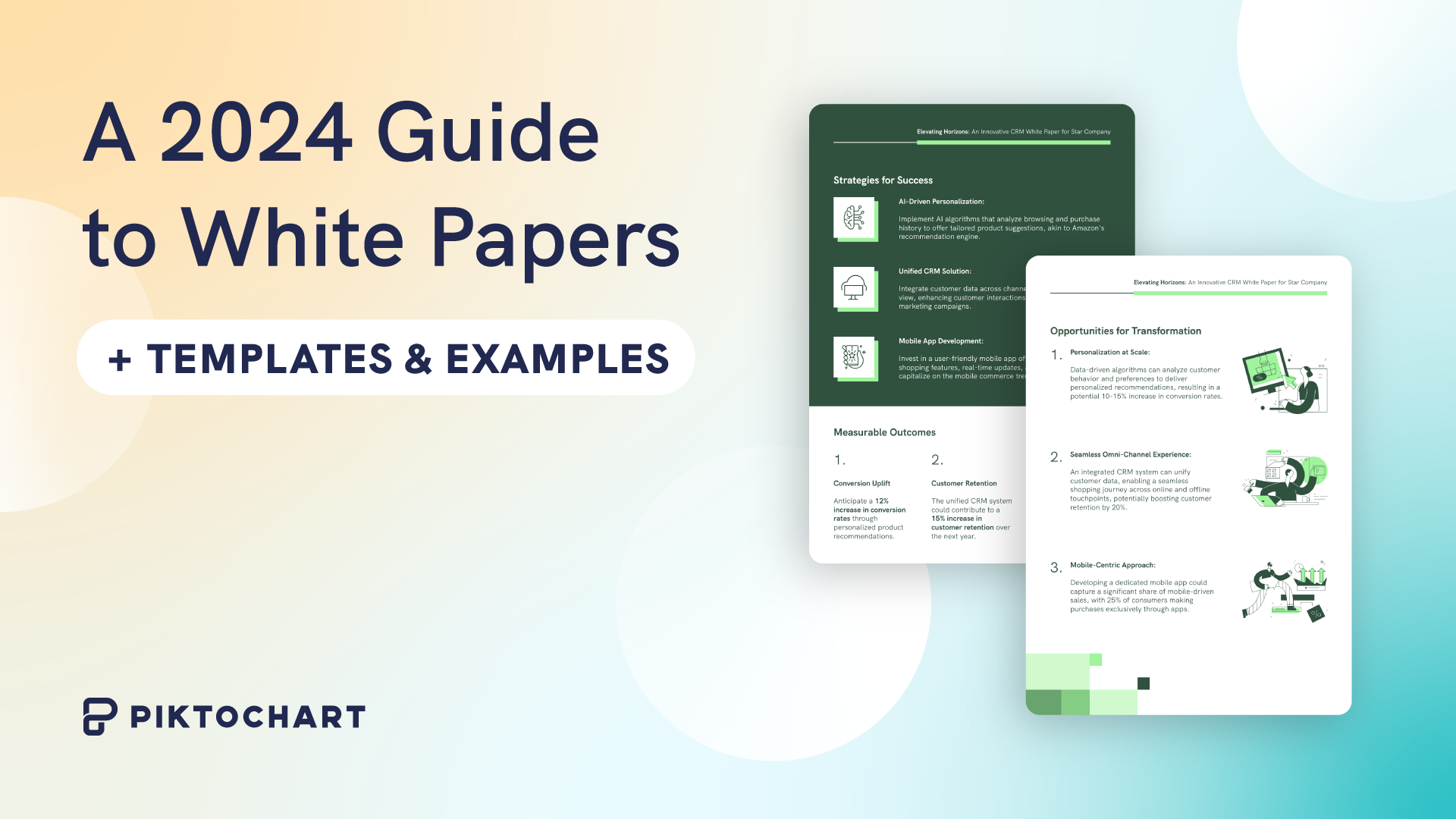White papers are an essential tool for establishing thought leadership, educating audiences, and generating leads. They offer a unique opportunity for companies to showcase their expertise and establish themselves as industry leaders. Plus, they’re not too difficult to create, especially with the right tools.
In this article, we’re going to look at what exactly white papers are and why they matter. We’re also going to give you white paper examples to inspire your next project, and what types of data visuals and designs you can include in your white paper to provide the most value.
If you want a hassle-free way to create these visuals, sign up for a free Piktochart account and use our platform to create professional-looking white papers in minutes.
Table of Contents
What is a White Paper?
A white paper presents information, research, or findings on a specific topic comprehensively and authoritatively. It presents research findings, incorporates expert opinions, and offers evidence-based recommendations. White papers are written in a clear, authoritative, and unbiased tone to establish the writer’s knowledge as respectable.
White papers are often used as marketing tools by businesses to show off their expertise and inform the target audience about a specific issue or solutions to a problem.
Because they provide valuable insight and solutions to problems that might be encountered by prospective customers, white papers are also a highly effective way of generating leads.
White papers are known for their in-depth analysis and research-based approach. They provide readers with a thorough understanding of the subject, supported by credible sources of information.
Types of White Papers
White papers can fit into four main categories, each with its own focus and purpose.
- Backgrounder/Product – Provides an in-depth look at a specific product/service. Highlights key features, benefits, and successful use cases.
- Numbered List/How-to – Written in a step-by-step format and contains instructions for readers for solving a problem or achieving an objective.
- Problem/Solution – The most common type of white paper, they identify a specific issue or challenge faced by the target audience and present a solution offered by the company, often to promote a product or service.
- Survey Findings/Market Research – Presents data and information from surveys or market research carried out by the organization used to showcase industry trends and consumer preferences, or to promote a product or service.
Elements of an Effective White Paper
The elements you should include in a well-drafted white paper are:
Compelling Title and Cover Page
Your white paper’s title and cover design form readers’ vital first impression. Craft a compelling title that clearly conveys the value readers will get. Use meaningful keywords to help it get found.
An eye-catching cover image can also help hook readers and set your white paper apart. But keep it professional – avoid cheesy stock photos.
Table of Contents and Executive Summary
A table of contents makes it easy for readers to navigate through the document and allows them to jump quickly to sections of interest.
Follow this with a concise executive summary. An executive summary presents a short overview of key points covered by the white paper. Call out the key problem, main takeaways, and a teaser of the solution. This sets expectations and motivates readers to dive in.
Logical Flow and Organization
A well-crafted white paper follows a logical flow and is organized in a way that makes it easy for the reader to follow. By flow, we mean it should have a clear introduction, main body, and conclusion. The main body should be divided into sections with catchy headings to keep the reader engaged. Then, these sections should “flow” into one another with transition words and sentences.
Having a logical flow not only improves readability but also adds credibility to your white paper. It shows that you have put thought and effort into creating the document, which reflects positively on your brand.
Skimmable Format
Not all readers will have the time or patience to read through your entire white paper. Use a skimmable format to make it easier to navigate and digest, no matter who your reader is.
Make an effort to include:
- Short paragraphs, centered around one idea at a time
- Bullet points, to emphasize lists that might get lost in paragraphs
- Headings and subheadings, to break up and organize your content
- Call outs and quotations, to highlight key points
- White space, to give your readers’ eyes a rest
- Visuals, to convey information quickly and make it easy to understand
Thought Leadership and Expertise
White papers aren’t just about promoting your products or services – they should be well-researched and provide valuable insights and information. This is where thought leadership comes in. By showcasing your expertise, you establish credibility and trust with your readers.
For example, if you’re a software company specializing in data analytics, you can create a white paper discussing the latest trends and best practices in the industry. By referencing your data, you demonstrate that you have unique and valuable knowledge from the field.
Design and Branding
It’s important to design and brand your white paper to draw attention and build credibility. Maintain consistency with the company image by following brand guidelines on color, font, and images. A professional and polished appearance will build trust with your audience and give your paper an authoritative feel.
In view of the growing popularity of digital formats, it is important to create interactive white papers that allow readers to engage with them through features like clickable links, videos, and animations. As a result, the reading experience is enhanced and sharing on social media platforms is made easier.
Call-to-Action
Ending your white paper with a clear call to action (CTA) is key. After reading, what are the next steps your reader should take? Prompt them to schedule a consultation, sign up for a newsletter, buy a product, or check out a resource. Whatever your paper hints at, this is the moment to bring it to the surface to make it easy for your reader to try.
White papers may also be gated, meaning that readers have to provide contact information before they can access the content. Businesses can use this to generate leads and build their email list.
White Paper Best Practices and Tips
Let’s take a look at some good practices and tips to create an efficient white paper.
You need to know the target audience and their pain points if you’re going to make it through your white papers.
What’s the challenge they’re facing? What’s the information they need to solve this problem? Use these insights to shape your white paper’s focus, structure, and language. The more relevant it is to readers’ needs, the more impact it will have.
A common mistake marketers make is to use white papers as a thinly veiled sales pitch. Instead, focus on educating the reader and providing them with valuable information. In this way, you build trust and demonstrate your credibility in your space.
Remember: you’re the authority, and you want to prove that, but your readers can’t always match that. Write clearly and simply without too much jargon or technical terminology to make your white paper accessible.
Don’t just post your white paper and pray. Actively promote it across multiple channels, such as:
- your websites
- email marketing
- social media platforms
- advertisements
The more touchpoints you create, the more likely it is that potential customers will read your white paper.
White papers are a valuable source of content because they are great for repurposing. You can, for example, turn key points from your white paper into blog posts, infographics, or even video content. This enables you to reach a variety of people and maximize the impact of your white paper.
Inspiring White Paper Examples
Looking for inspiration for your next white paper? These examples from various industries showcase the diverse possibilities of the format.
Source: Infigo
This paper highlights research on the current state of marketing automation and its implications for businesses. You’ll notice Ascend2 utilizes stacked bar charts to visualize the data they include, making it more accessible. Stacked bar charts are available with Piktochart’s functions.
This is an in-depth analysis of the trends, strategies, and best practices for businesses advertising on social media, made into an article. They know what they’re doing by posting this white paper as an article, using pre-written content to boost engagement on their blog. Piktochart has tons of templates that can help you do this for any format.
The future of work and how technology will shape it in the years to come is explored in this Cornell white paper. While it may not be the most dynamic of our examples, they use branding that carries through at the top and bottom of every page to keep things consistent.
This white paper looks at how web-to-print software can help your printing business grow through personalization. It illustrates this point perfectly with stunning visuals and dynamic colors throughout that keep you engaged while reading, hence why they are our example above. Piktochart can help you create something just as visually beautiful that will keep your audience looking.
This white paper provides a comprehensive overview of the current state of cybersecurity, its challenges, and emerging threats. Based on a survey of 3,000 IT professionals in 14 countries, it’s a report with lots of hype around it, but Sophos utilizes the paywall method to keep this valuable information to only those who give them more valuable information.
A step-by-step guide on creating effective email marketing campaigns is presented in this white paper. It’s a lengthy document, so AWeber breaks it up using headers and a table of contents so you can navigate to the info you need quickly.
The results of a survey that asked over 500 marketing professionals about event planning in the face of worldwide uncertainty can be found in this paper. This is another whitepaper that uses a pay/information wall, which positions their white paper as a method for gettting capital.
This white paper provides an in-depth analysis of search engine optimization (SEO) and its importance of online businesses. Pimberly does a great job of gauging interest up front, not only by asking for an email, but also by providing a summary and an expected read time, 15 minutes.
This white paper explores the rise of remote work and its potential benefits for businesses. IBM uses plenty of white space and visuals to keep their paper interesting, formatting you can recreate easily with Piktochart’s dynamic templates.
The benefits of video marketing for businesses, including the impact on customer engagement and brand awareness, are dealt with in this white paper. While video is hard to capture in a physical document, Charters uses links and tons of photos to get physical examples in his work, making it accessible and fun as well as informative.
Conclusion and Next Steps
White papers are a vital tool for businesses who seek to establish themselves as though leaders and draw up leads. Through research and a clear tone of voice, they provide useful information and solutions to audiences. If you take the advice given above, you’ll be well on your way to producing a persuasive and visually stunning white paper.
If you’d like some extra help, Piktochart provides any white paper template you might need to start your business, including the following:
Here’s an example of what your white paper could look like with our help:
Source: Piktochart
Our easy-to-use platform makes it simple for non-designers to create professional-looking white papers in minutes. And if you need additional assistance or guidance, our team is always available to help.
A white paper shouldn’t be hard to make or read. Sign up with Piktochart today and start making next-level content that pushes your business further than ever before!
Frequently Asked Questions
How to Write a Whitepaper?
Writing a white paper can be tough, but it can be an effective lead generation tool by providing valuable in-demand content to your target audience. We have a few steps to follow to help you start:
- Choose a Topic: Select an appropriate and efficient topic based on your business/industry experience.
- Research: Conduct extensive research on the selected topic so that you have solid data, statistics, and insights for your white paper.
- Outline: Create an outline that includes key points you want to cover in each section of the white paper.
- Introduction: There’s a reason you’re writing this white paper and why your audience is reading it, so start with an attractive introduction that clearly sets out the purpose.
- Body: Present your findings, data, and analysis in a logical order with supporting evidence and examples.
- Conclusion: Summarize your main points and come up with recommendations/solutions based on the information you provided.
- Design: Use graphics like graphs, charts, and illustrations to make your white paper more interactive and easier to read.
- Proofread: Prior to publication, make sure all grammatical and spelling errors have been rectified.
What is a White Paper Template?
A white paper template is a pre-planned document which can be used as a starting point to draw up a paper. It’s composed of sections like:
- introduction
- problem statement
- research and analysis
- recommendations
- conclusion
The time needed to complete the white paper can be reduced by using templates, with a view to ensuring that its structure is consistent. It is also a good way to ensure that you don’t miss anything of importance in each section.
What is the Difference Between a White Paper and a Report?
While both white papers and reports present information, there are some important differences.
Reports are often more factual and objective than white papers, while white papers usually use a more persuasive tone to convince readers of a specific point or solution. Compared to reports, white papers tend to be more detailed and complex.
They can also be used at different times. Reports are generally drawn up after a project is completed, while white papers are often used at the beginning of projects or for proposing solutions.
What are White Papers Examples?
White papers can cover a wide range of topics and industries. While we have some specific examples listed above, here is what they would generally look like in some of the most prominent industries:
- Technology – A white paper that discusses the benefits fo using cloud computing for businesses.
- Healthcare – A white paper that examines the impact of telemedicine on patient care.
- Finance – A white paper that analyzes the use of blockchain technology in financial transactions.
Why is it Called a White Paper?
The term “white paper” originated in the United Kingdom’s government as a way to present policy proposals. They were called white papers because they were typically printed on white paper and presented factual information without any bias or opinion, making them pure or “white”.
Who Writes White Papers?
White papers are usually written by experts in a specific field, such as industry professionals or academics. They have the knowledge and expertise to provide valuable insights and analysis on complex topics.
Within a company, white papers can be written by various departments, such as marketing, research and development, or product teams. It is important to have a strong understanding of the topic and access to relevant data when writing a white paper, so think about who in your company would be best qualified to talk about the task at hand authoritatively when deciding who will write your white paper.
How Long Should a Whitepaper be?
Typically, white papers range from 6 to 20 pages. However, the length can vary depending on the complexity of the topic and the amount of research and data presented. For simpler topics, or those that they plan to repurpose as a social media post, some companies prefer to use a one page white paper.
What are Good White Paper Topics?
White papers are usually focused on a specific industry or problem that your business addresses. Some examples of topics for white papers could be:
- The Future of Artificial Intelligence in Healthcare
- The Impact of Social Media Marketing on Consumer Behavior
- Sustainable Solutions for Environmental Conservation
It is essential to choose a topic that aligns with your business and can provide valuable insights to your target audience.




